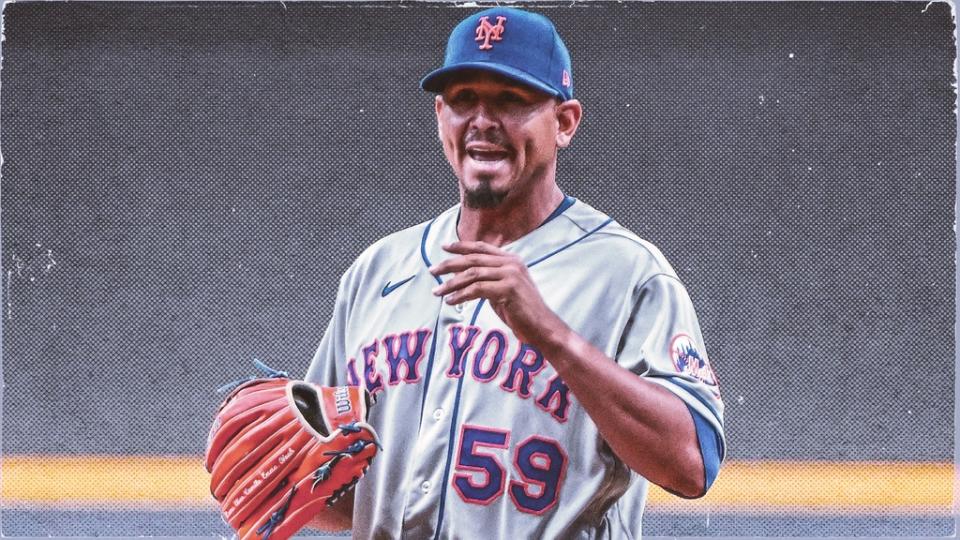Mets RHP Carlos Carrasco's first start of season was alarming for multiple reasons

It's dangerous to draw conclusions when the sample size under discussion is small. That's what makes it tricky to delve deep into what happened to Mets right-hander Carlos Carrasco on Monday afternoon in Milwaukee.
But the extent to which Carrasco struggled -- combined with an alarming velocity dip and how he ended his 2022 season -- makes it fair to at least wonder if it's a harbinger of things to come.
While getting hit around by the Brewers, there were a number of things that stood out as concerns.
The first, and most important, was the serious dip in the velocity of Carrasco's four-seam fastball as the game went on, with it dropping as low as 88 mph. Carrasco averaged 91.6 mph on the offering last season after averaging 92.9 mph in 2020.
It was a topic on the SNY broadcast, and a discussion on social media. After the game, MLB.com's Anthony DiComo noted that Carrasco threw eight of his four-seamers below 90 mph, explaining that during the entirety of Carrasco's five prior seasons, he threw seven four-seamers total below 90 mph.
Following Carrasco's start, he and manager Buck Showalter downplayed the rough outing and velocity dip. Carrasco seemed to attribute some of his troubles to adjusting to the pitch clock, while Showalter said Carrasco's velocity wasn't an issue.
"Not really, that’s just normal," Showalter said. "He’s where he needs to be range-wise, where he normally is for the most part. I haven’t looked at it closely yet. I don’t go much by the guns, they’re normally not very accurate."
Noted Carrasco about his velocity:
"I think the pitch count got up there. There was a lot of pitches in there. I don’t know, it was 80-something-plus pitches. A couple long innings. … Everything feels nice, feels normal, but I had some long innings. I pay attention to my velocity, so I just want to know where I am. This is the first game, so we have more games coming, and just get it from there."
What made Carrasco's velocity dip so alarming was that he so rarely had his fastball drop that low over the previous half decade. Perhaps it was simply due to him running out of gas and being pushed longer than he should've in his first start of the season.
It might also have been impacted by the pitch clock. The righty was dinged for a few violations during his outing, and -- like every other pitcher -- is adjusting to the quickened pace he must work at now.

To that end, it should be pointed out that Showalter keeping Carrasco in for the fifth inning when he was above 80 pitches and laboring so badly was bizarre, did his pitcher a disservice, and led to the game getting completely out of hand.
But even before Carrasco seemingly wore down, he was all over the place as he struggled badly with his control while constantly falling behind hitters. Of Carrasco's 96 pitches, his strike-to-ball ratio was ugly -- 53 strikes and 43 balls.
Before continuing, it should be pointed out that -- at least as it pertains to Carrasco's later-inning difficulties on Monday -- he's not alone. Many pitchers seriously tire early in the season as the games go on, and Max Scherzer's sixth-inning trouble in his first start is one example. And again, these guys are adjusting to a new way of pitching because of the clock.
However, what makes Carrasco's velocity dip and overall scuffling in his first outing so unnerving is that it was a continuation of the final six weeks of his 2022 season.
While Carrasco was a key cog in the rotation and performed well overall, his outings from Aug. 15 on were disconcerting.
Over his last seven starts, Carrasco's numbers were poor (4.88 ERA and an opposing triple slash of .296/.354/.504), but the main concern was his inability to provide length -- which reared its head again on Monday as he tossed just four innings.
That seven-start stretch included outings of 2.0, 2.2, and 3.0 innings pitched, and two starts of 4.0 innings pitched. That first 2.0-inning stint came on Aug. 15 in a blowout loss to the Braves in Atlanta, when Carrasco left early with left side tightness after allowing three runs on four hits. That injury kept him out until Sept. 4.
Carrasco fared so badly over his final three starts (including a terrible performance against the Marlins in Miami during a loss on Sept. 27) that there was a question of whether he would even make his final start if the Mets were still in serious contention for the NL East title. They were not, and he did.
The above is what made it fair to wonder which Carrasco the Mets would be getting this season in his age-36 campaign.
Hopefully for the Mets and Carrasco, what befell him against the Brewers was just a blip and not a continuation of the worrying trend from the end of last season.
If, however, Carrasco is going to be a pitcher who often fails to provide much length, the Mets will have to reassess his role sooner rather than later.

